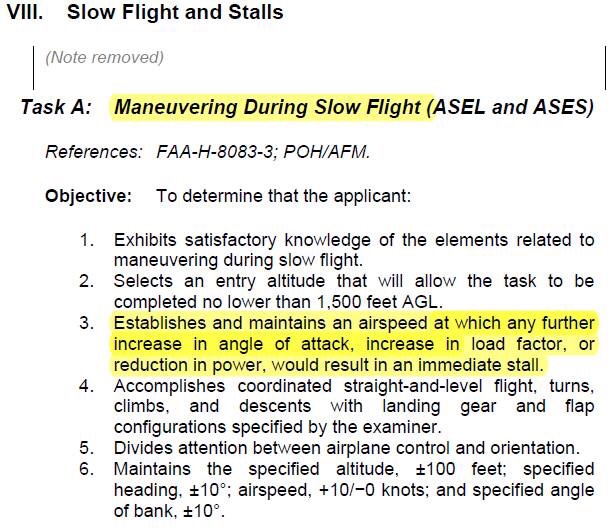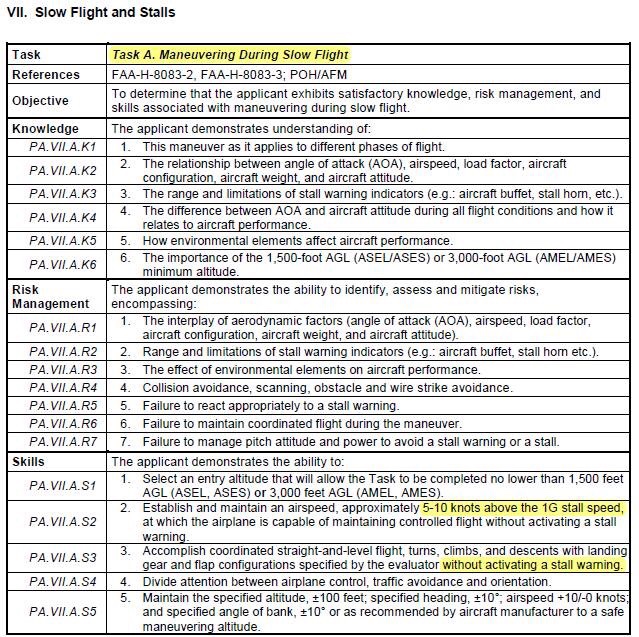Been some further interesting discussion on Rod's FB page.
I attended an FAA online seminar about the ACS on Saturday. Some points they were pushing :
- ACS was not intended to lengthen Private or Instrument checkrides. (See commentary below...)
- DPEs who decided the ACS meant that they were supposed to test all 300+ coded items, were wrong.
- DPEs who thought that because Knowledge, Risk, and Skill items were categorized together on a single page that they had to be done at the same time in the checkride... (As in, while flying...)... Were wrong.
How it really works...
There are 51 major tasks in the ACS for the Private certificate. Under those tasks are close to 400 sub-tasks that are coded. They're broken up into Knowledge, Risk, and Skills tasks.
Knowledge tasks are literally the things being tested in the written test.
Risk tasks are risk analysis/awareness questions and tasks.
Skills are flying skills, very detailed versions of basically what the PTS used to be.
On a checkride...
DPE is required to create scenarios and questions that will assess...
One Knowledge task from all 51 main tasks.
One Risk task from all 51 main tasks.
All Skills tasks from all 51 main tasks.
Additionally any missed questions in the written will be given a code similar to the old "PLT" codes but these directly correlate to items in the ACS (much easier to look up and know what specifically was missed).
DPE is required to cover all codes missed on the written.
DPE at their discretion may add any additional coded items to the checkride that they wish.
Thoughts and commentary...
(A mash-up of my writing here and some of the other online commentary about it all...)
DPE has a lot on their plate to assess 102 Knowledge and risk analysis items in every oral. Plus all the flying skills.
Some of the flying skills are perhaps botched and FAA is reviewing them. Example: Slow flight is now defined as 10 knots above stall WARNING. Folks definitely don't seem to like that one.
FAAs assertion that tests should not be longer may be an indication of something wrong in their measurement of PTS tests. Or not. Various commentary on that. But most folks think figuring out scenarios to cover 102 items is going to be pretty entertaining for them and could really up the time required and/or as some in the instructing biz are concerned about, jump the price of Private and Instrument rides.
(I haven't counted the number of major tasks or sub-tasks for the Instrument. Nor seen anyone else do it yet. Feel free.)
There's a general feel amongst the commentators of two things:
The risk analysis stuff is overdone. Some are even concerned about the physical placement of these tasks in the document. (Stuff is always ordered Knowledge, Risk, and then Skill, but the Skill items are the required items. Seems to give a hint that the risk items are being pushed hard.)
Long time instructors are a bit concerned about having to sign that they've taught over 300 items adequately to folks. (A lot of this stuff was self-study in the past and instructor evaluated whether you knew it or not. Now it's detailed to the Nth degree. And still supposed to be "scenario" based by the time you get to the DPE, not "list" based. But DPE has to cover 51 of them, and instructor must sign off on over 300 total, close to 400.)
Anyway, the other larger concern is nobody knows other than FAA feeling more organized about it all, what the goal really is. Folks are imagining an intense number of items in higher ratings and CFI ratings later on.
FAA feels they were just "writing a standard that didn't exist and needed to".
FAA also pushed pretty hard in the seminar that "industry" was consulted for all of this. List of places was notably major training sellers and major schools who some say may benefit from a much more complex system. (Wear tin foil hat on that one or not, your choice. I'm just typing up what I'm reading for discussion here.)
Rod Machado and others are involved in some very public but civil debates about the purpose of the changes and trying to relate them back to safety changes needed or training faults found that needed correction. Really from my reading, none of the ACS advocates talking to them are saying that it was intended to do that. It seems more like they were very concerned that the PTS would say three lines after "Pre-flight" and it wasn't detailed enough.
Which is kinda odd in my opinion. DPEs usually don't get to be DPEs without knowing all the steps of a proper pre-flight. Doesn't seem like it was necessary to replace those three sub-items with a huge list for them. Just my thoughts.
Anyway, the seminar was interesting. Rotorcraft and Powered Lift versions of the ACS at Private and Instrument levels have not been completed nor implemented. In fact, rotorcraft will be a mix of ACS and PTS for the time being. (Ick. Messy.)
One question was during the transition year where students took the old written and got "PLT" codes for failed test questions, would there be a chart mapping those to ACS codes. Answer: No. (Again messy/disorganized IMHO...)
Also noted heavily was that higher ratings will take YEARS to implement into ACS. Two minimum, probably more.
So Private and Instrument applicants will be using one system, and everyone else, another. Also extremely messy organizationally to me, but maybe it works.
FAA said all questions asked during the seminar would be answered live or via email within "a few weeks". My question was the only unanswered one live, and I suspect I know why...
I asked...
Are the FIA and FII written tests already changing because their test pools are linked to the Private and Instrument test pools?
No answer. And the reason probably is that they can't admit the test pools are inextricably linked in a database, and test questions are the big "super secret" for the last 12 years or so, so the question causes problems to answer it. But I suspect that ACS is creeping into the other writtens via the question pool being linked from my recent mass taking of multiple writtens.
Of course FAA can update the non-ACS tests anytime they feel like it, so it's not really a big deal, but expect more scenario type questions to creep over from Private and Instrument into the other tests is all I'm saying. Hard not to have that happen even though officially no ACS changes have been done outside of Private and Instrument.
Anyway there's some brain dump stuff.
And of course there's also just general confusion going on. Some poor Private applicant posted happily that he passed his "8 hour oral" on Facebook and both sides lost their minds on the whole time aspect, until someone dragged the guy back to a keyboard to explain that it was a 3 hour oral with a bunch of aircraft and weather problems.
Slap forehead...
At least FAA is doing seminars and doing them via GoToSeminar direct out of OKC. Sign up for one if the ACS is going to affect you. It's an easy hour of info and "polls" (quizzes) and gives the basics of how the monster document works.
I figured I'd better take one, being that when I finally get this CFI rating stuff done, I had better know what I need to teach... I'll never have a Private PTS-style applicant ever...
So ACS it is...


